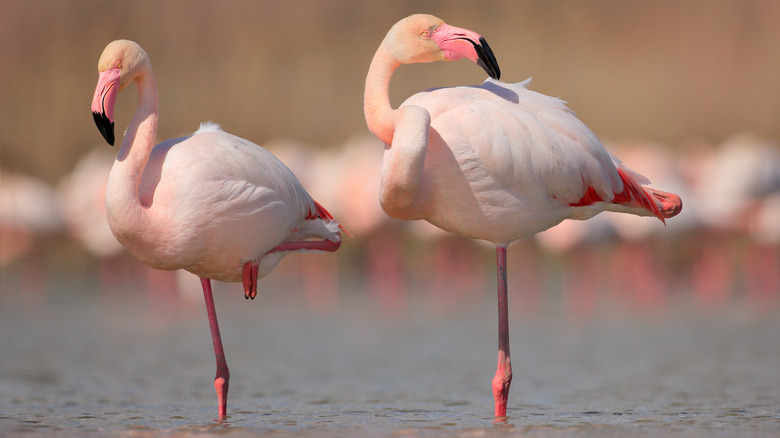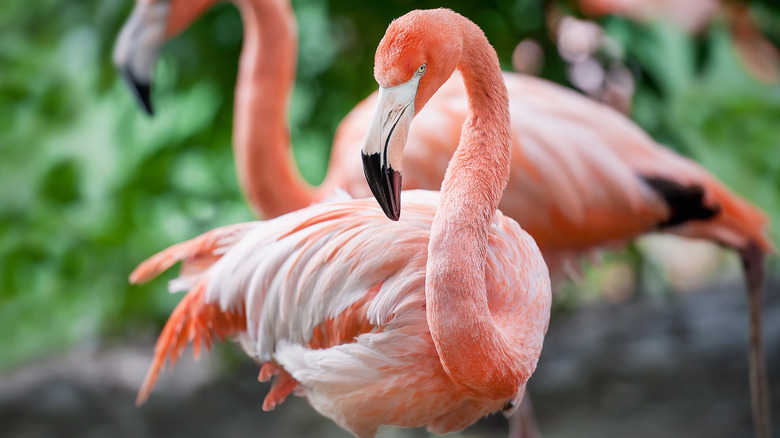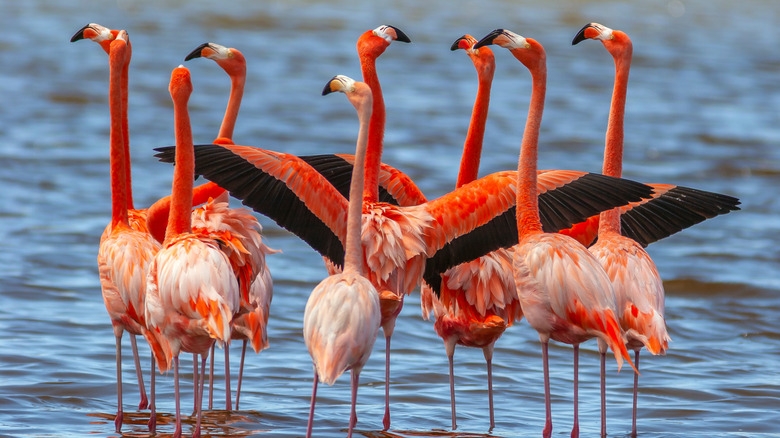Why Do Flamingos Only Stand On One Leg?
Flamingos are one of the most widely-recognized birds in the world. Perhaps this is because of the iconic (or perhaps infamous) plastic flamingo lawn decorations. They seem to be a common bird of choice for classic outdoor décor. Whether one encounters flamingos in person or in plastic, they leave a unique impression for multiple reasons.
The first thing that may come to mind when thinking of flamingos is likely their color. Flamingo feathers start off fuzzy and grey, but by adulthood, they can be pink, white, orange, or a salmon-colored shade. Flamingos can reach close to five feet in height with a wingspan that also approaches five feet in width. The reason behind this is their diet, which has nutrients similar to those in carrots. If humans consumed enough carrots, or other foods with carotenoid pigments, it would affect our skin in the same way that it affects the flamingos (via San Diego Zoo).
Flamingos can reach nearly five feet in height
These colorful birds have habitats on five continents: North America, South America, Africa, Asia, and Europe (no, you won't find any in Antarctica or Australia). They tend to stick to warmer areas of these continents, and there are a few variations from place to place, mainly in size and color. Puna flamingos in parts of South America have yellow beaks opposed to black or pink beaks, as shown by Discover Wildlife. On thing flamingos do have in common are their legs.
As previously mentioned, flamingos can reach close to five feet in height, but most of this height is just from their legs. They have long, thin legs with webbed feet that are often the same color as the rest of the flamingo's body. Of course, the biggest stand-out feature of a flamingo's legs is the fact that they sometimes only stand on one leg at a time.
It is not entirely clear why flamingos stand on one leg
Scientists have quite a few theories as to why flamingos stand on one leg. Treehugger explains that researchers from Emory University found that flamingos can use one leg without actually using any muscles. It is just easier for them to use one leg, as it does not cause any balance issues. Flamingos use passive bodily mechanisms for balance as shown by their ability to remain standing on one leg even while asleep. Perhaps this is similar to how humans breathe without conscious muscle use.
Another explanation for their seemingly cumbersome stance is body heat conservation. When standing on one leg, the other leg is tucked up against the flamingo's body, which could keep it warm with body heat. The reasoning behind this theory is that flamingos stand on one leg more often while wading in bodies of water than when on land (via New Scientist).
Luckily, scientists will have more time to figure out what makes a flamingo tick. No species of flamingo has found itself on the endangered list, but human activity is quickly encroaching upon their habitats, according to PBS. Such human activity and population growth are the driving forces behind animal extinction today, creating a biodiversity crisis that affects us all.


